SURVIVAL IN THE SADDLE • PART 9
In this feature we’ll explore the topic of motorcycle riding in high winds. The Roadcraft USA mission is to help motorcyclists of all skill levels have safer and more rewarding experiences on the road. We have already discussed the subjects of intersections, visibility and parked car hazards. Our riding skills posts have touched upon the subjects of riding in the rain, carving up the curvy roads and navigating the superhighways. Informative features on the Roadcraft USA resource are being added constantly. We suggest you bookmark the site so you can return, visit and learn at your convenience. We also recommend that you subscribe to Roadcraft USA. We send out occasional emails to alert subscribers when new features are published.
Riding In High Winds

Riding in high winds is similar to riding in the rain. It’s not ideal, but it’s perfectly doable. It’s also similar in that you’ll need to log quite a few miles in some uncomfortable conditions before your skill and confidence levels reach their peak. Start slowly. Don’t go out and try to take on a hurricane for your first venture in the breeze. Expose yourself gradually to windy…then windier…conditions as you develop your skills. It’s not something to be afraid of. But it’s certainly something to pay attention to…and to respect.
Make no mistake: motorcycles can be very tricky to handle in windy conditions. Crosswinds, those that are striking you from either side; are more disconcerting than headwinds or tail winds. Continuous steady winds are easier to manage than strong gusts. Let’s explore some of the factors that can make or break your encounters with windy conditions.
The Type Of Bike You Ride
I spent nearly 25 years in the saddle of large V-Twin American touring bikes. A few of those weighed in excess of 900 pounds. That’s before I added my weight, the weight of a passenger and the additional weight of our luggage. Today I ride a European sport touring bike that hits the scales at just under 500 pounds.
I took delivery of this middleweight motorcycle on a gusty, windy, autumn day; from a dealership located some 150 highway miles from my home. After more than two decades in the saddle of my “Grandpa-Glides” I wasn’t ready for what I experienced on my maiden voyage home. Long story short: it was a hair-raising experience. I was getting blown, uncontrollably, all over the highway. I couldn’t believe that this new motorcycle was designed, built and sold in a country of Alpine heritage. I spent the entire trip home seriously questioning whether or not I had made a drastic mistake.
It didn’t take long for me to become comfortable with the little sport-tourer’s characteristics. And it taught me some very valuable lessons about motorcycle design, ergonomics and practical use. All of which are much more important than sheer weight when it comes to riding in high winds. I’ll share some of those lessons here.
Heavyweight Touring Bike -Vs- Lightweight Sport Tourer
The difference in handling the wind has almost nothing to do with weight. Sheer mass has very little to do with keeping your bike firmly planted on the ground in windy conditions. What riders need to concern themselves with is the bike’s center of gravity and its profile. These items are functions of two main factors: the actual design of the bike and how you choose to load and outfit it.
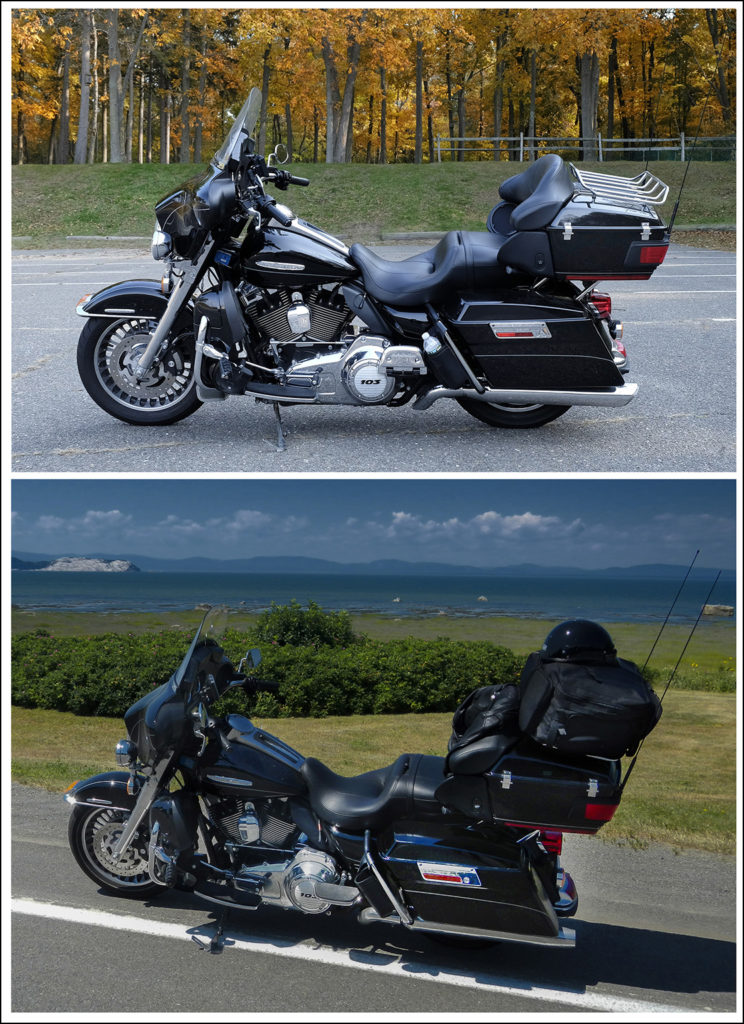
The image above shows two different views of my last Harley-Davidson® Ultra Limited touring bike. Same bike in both pictures. Entirely different animals in windy conditions. The top picture shows the way the bike looks rolling off the showroom floor. With its heavy V-Twin motor, transmission and primary drive mounted low in the chassis, this model Harley is known for its exceptional handling characteristics among large bikes. There’s a reason many law enforcement agencies choose this model for their motor pools.
However; take the same bike, fill up the Tour Pack (top case), toss some more luggage on top of the luggage rack and throw on a passenger for good luck, and you have a near uncontrollable beast. The difference: Center of gravity and profile. Adding all that weight and wind resistance up high makes the bike more susceptible to the effects of wind.
The Fairing Factor
The design of the motorcycle’s fairing has a lot to do with its performance when riding in high winds. Probably not the way you think, or for the reasons you think, however. The timeless “Bat Wing” style fairing has adorned Harley-Davidson® Touring models since its introduction in 1969. The “Bat Wing” style fairing is mounted to the front forks. Starting with the 1980 model year Harley began offering a new frame mounted fairing. This new model was dubbed the Tour Glide® and has evolved into what is known today as the Road Glide®. Both of these styles are still available and are shown in the photos below.
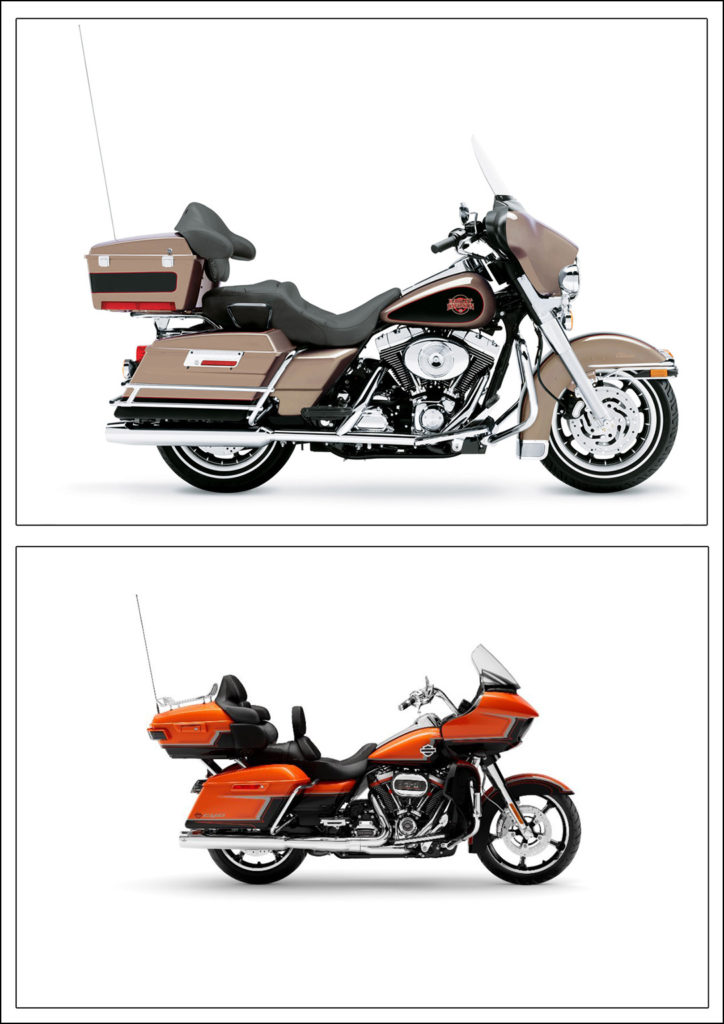
The casual observer might think that the fork-mounted “Bat Wing” style fairing would make the motorcycle more susceptible to the effects of wind gusts than the frame mounted fairing on the Road Glide® models. The exact opposite is true. Both fairing styles are substantial in size and have large surface areas that catch the wind. The force of the wind on the fork-mounted “Bat Wing” fairing, however, is applied downward onto the front wheel applying greater steering force to that all important front tire contact patch…a definite advantage when riding in high winds.
Riding Position
No discussion of riding in high winds would be complete without a few comments on ergonomics. Where the rider is seated, in relation to the motorcycle’s footrests and handlebars is paramount to the bike’s handling of windy conditions. Under ideal circumstances the rider’s weight should be directly over the footpegs. This allows the rider to shift weight from one footpeg to the other while keeping the knees close to the center of the bike.
Big cruisers, with forward controls and raised handlebars are not ideal in windy scenarios. The laid back seating position may be comfortable on nice days, but when riding in high winds they are difficult to make the instantaneous steering corrections that will be necessary.
Similarly, high performance sport bikes present problems on windy days. The rider’s arms are usually in a lower and narrower position (such as with clip-on style handlebars) and require more effort to make those constant steering corrections that are required when riding in high winds. Though better-suited for windy conditions than the laid back riding position of cruiser style bikes, the sport bikes can wreak havoc on a the rider’s shoulders and upper back on very windy days.
When I transitioned from decades of riding heavyweight touring bikes to riding a sport touring machine I became acutely aware of how much a rider’s seating position affected one’s ability to navigate when riding in high winds. Steering input is efficient and effortless. Weight transfer from one footpeg to the other is immediate. I found my sub-five hundred pound bike to actually be more maneuverable (and thus more sure-footed) when riding in high winds.
What You’ll Encounter
When riding in a strong crosswind you’ll find yourself leaning the bike into the wind. In the diagram below you’ll see a rider experiencing a steady wind from the left side. By leaning the bike into the wind the rider remains on a straight course.

If the bike drifts further to the right (from the force of the wind) the rider must compensate by leaning the bike even more to the left. This is accomplished by pressing harder on the upwind (left) hand grip. Keep in mind that all-important contact patch of the front wheel. We discussed this in great detail in an earlier post. Its relative size decreases as the bike is leaned over, so you will experience a different “feel” in the front end than you do when riding erect under nice calm conditions. Be ready for this. It’s not dangerous; but it will concern you when you experience it for the first one hundred times or so.
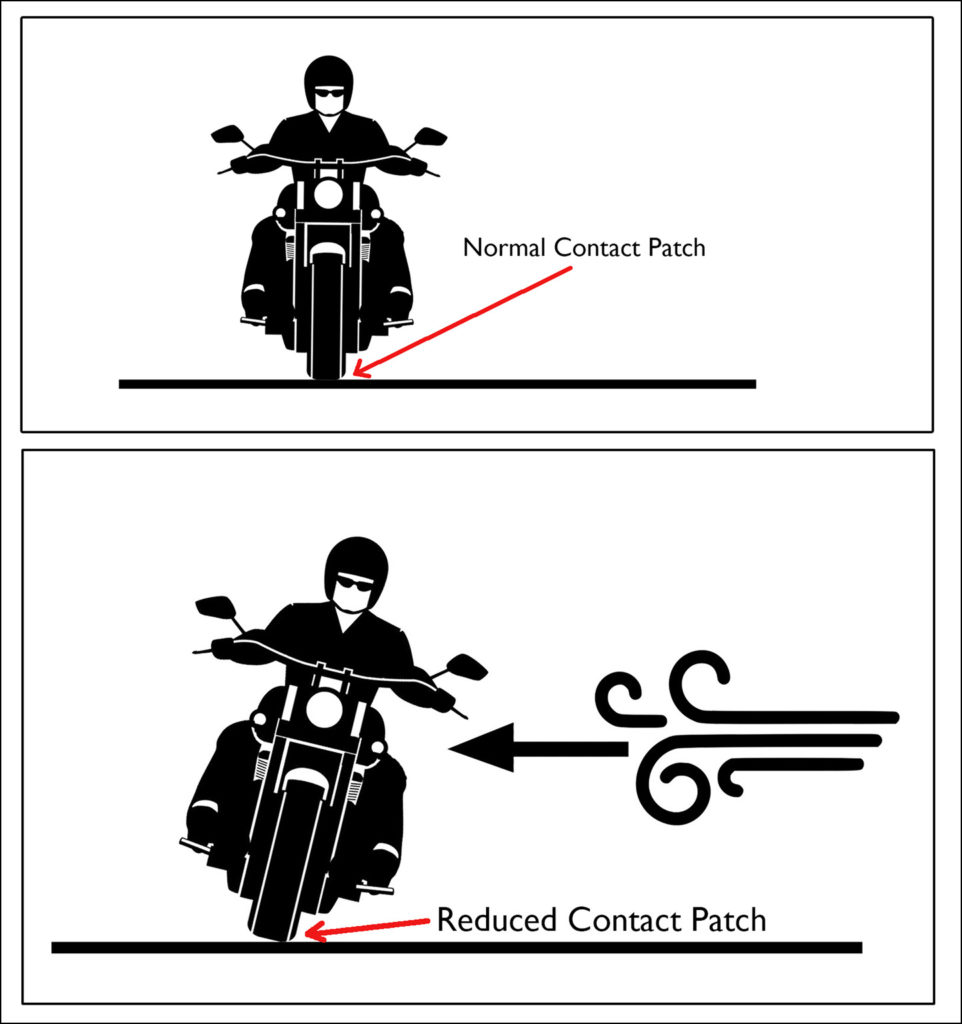
Handling The Gusts
Riding in a steady wind is a fairly straightforward proposition. Lean into the wind and apply pressure to the upwind grip. Easy. The real challenges come when the wind is gusting.
Handling the wind gusts is just a matter of reacting to them appropriately and as quickly as possible. When the wind gusts you’ll have to countersteer upwind in the right amount and for the correct amount of time. The object, obviously, is to keep the bike in an upright position and moving forward in a straight line. Sadly, I can’t impart any great words of wisdom here. You’ll have to get out and experience it and practice.
As stated earlier, start slow and build your skills. Go out on a day when it’s blowing 15MPH and gusting to 20 or 25. Start on some protected back roads. Move onto some secondary roads where wind is more of a factor (farmlands, industrial areas, etc). Then venture out onto the superhighways.
Practice Makes Perfect
When you’re confident under the aforementioned conditions, take it up a notch or two. Go out on a day when it’s blowing 30MPH with higher gusts. You’ll soon become confident that you’re not going to get blown over, tossed off the road or pushed into oncoming or parallel traffic. These are all very real possibilities, mind you. But the chances of them becoming a catastrophic reality are all but eliminated once you’ve got your skills dialed in. It takes time.
I “practice” countersteering all the time. Even on nice days in gentle turns. I’ll intentionally countersteer the bike when simply leaning it would be sufficient for me to navigate a given corner. Why? It makes my countersteering skills more instinctive when I’m called upon using them when absolutely necessary. Riding in high winds and experiencing higher wind gusts is one of those times. The more immediate and appropriate your response to those gusting winds, the better your riding experience will be.
Trouble Spots
Watch out for obstacles that can amplify the effect of wind gusts. These can be moving high profile vehicles such as trucks and buses. These can be fixed objects such as tunnels and highway overpasses.
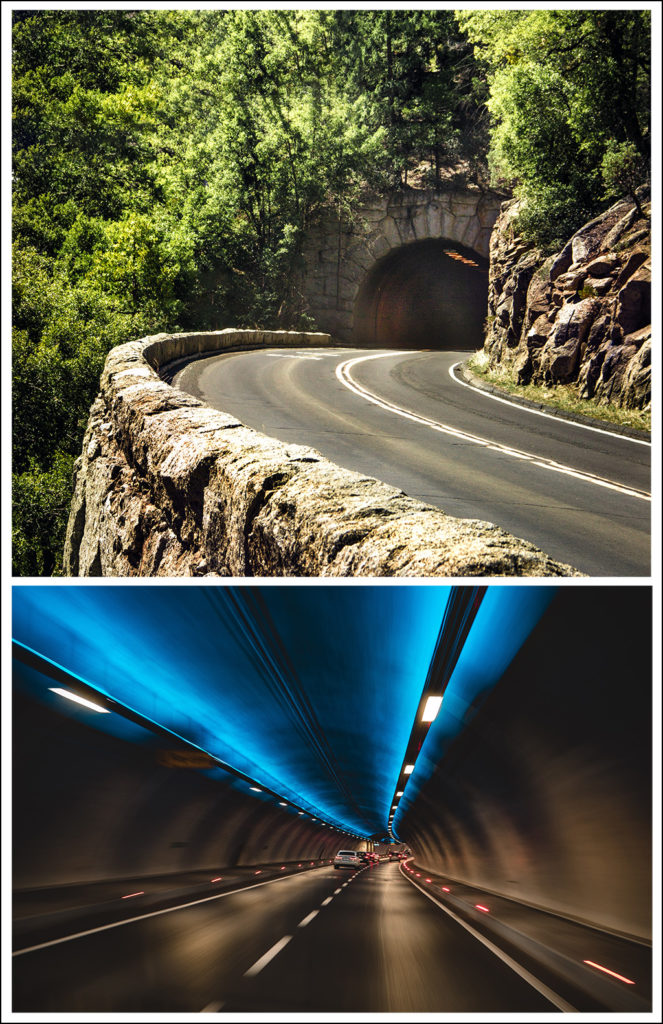
When you’re riding along in a steady wind and enter a tunnel the wind will abruptly stop blowing. You’ve been countersteering and/or leaning into the wind and it’s suddenly gone! You’ll need to react. Quickly. Unlike an unpredictable wind gust you can see these obstacles coming. You can be ready for the sudden change in wind force. If you’re being observant, you will be.
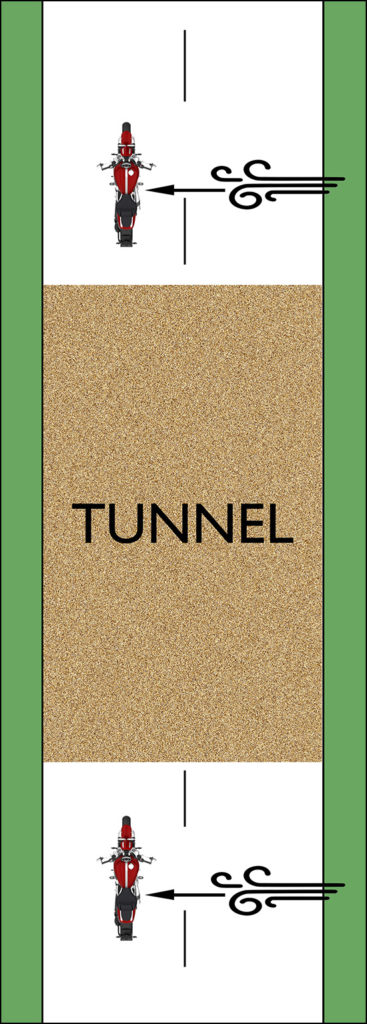
Remember that the opposite condition will present itself as you exit the tunnel and/or overpass. You’ll go from a protected, wind-free condition right back into the steady wind you had experienced before you entered the protected area. Be ready to get right back into your wind-riding mode of leaning and/or countersteering to the upwind side. Again, there’s no excuse for not being ready for this change in wind conditions. You can see it unfolding before you.
Going Green. Seeing Red
Another thing to look out for on the road are isolated wind turbines and large, expansive wind farms. Those things are there for a reason. That’s where the wind is…on a regular basis and in substantial strength. Though you’ll usually encounter steady winds in these spots (as opposed to unpredictable gusts) rest assured the wind will be powerful. Get ready to adopt your lean upwind posture for a while.
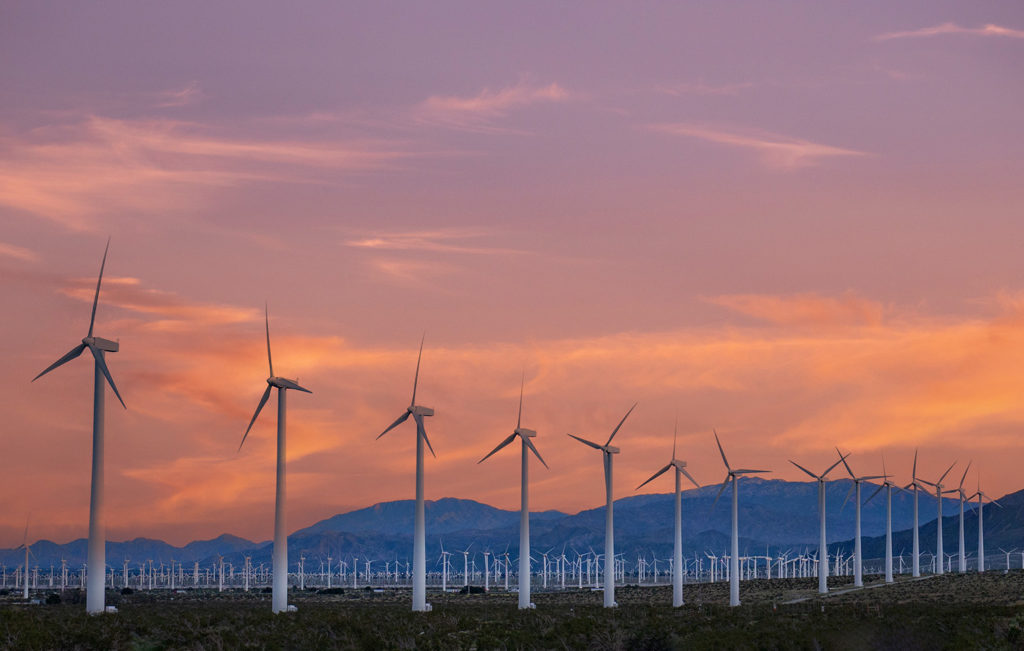
High Profile Vehicles
The same holds true when you pass, or get passed, by a high profile vehicle such as a truck, bus or tractor-trailer. The large vehicle will temporarily block the wind in the same way that the tunnel or overpass did in the scenario described above.
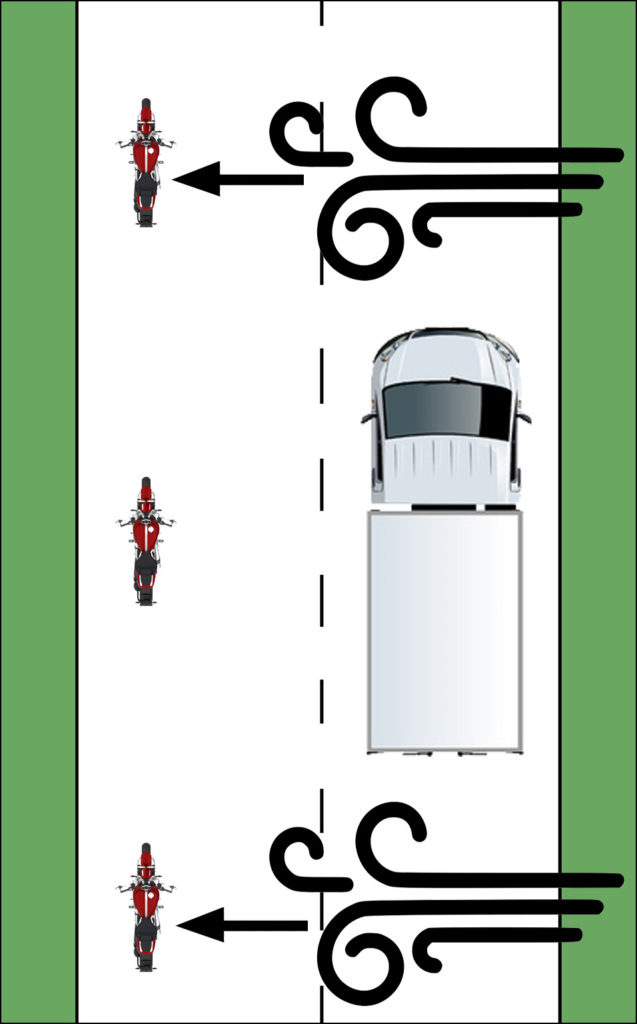
Be ready to adjust your riding for the immediate absence of wind as you pass, or get passed by, the large vehicle. Be prepared for the sudden reappearance of the wind when the pass is completed.
Not Just Highways
This post was published immediately following some features dealing with safely riding the superhighways. That was not simply a coincidence. The high wind conditions you’ll experience out on the road become especially troublesome at higher speeds on open highways.
Riding in high winds is not just worrisome on the major highways. You’ll experience difficult wind conditions on secondary roads; particularly those that run alongside large expanses of open land…farms, industrial areas, etc. On the windiest of days you might even encounter high winds on protected back roads. Be especially careful when a high profile vehicle is approaching from the opposite direction. The combined effect of wind buffeting and blocking the steady ambient wind can be overwhelming. Move to a position in your traffic lane as far away from the approaching vehicle as possible and be prepared to react quickly and appropriately as you pass.
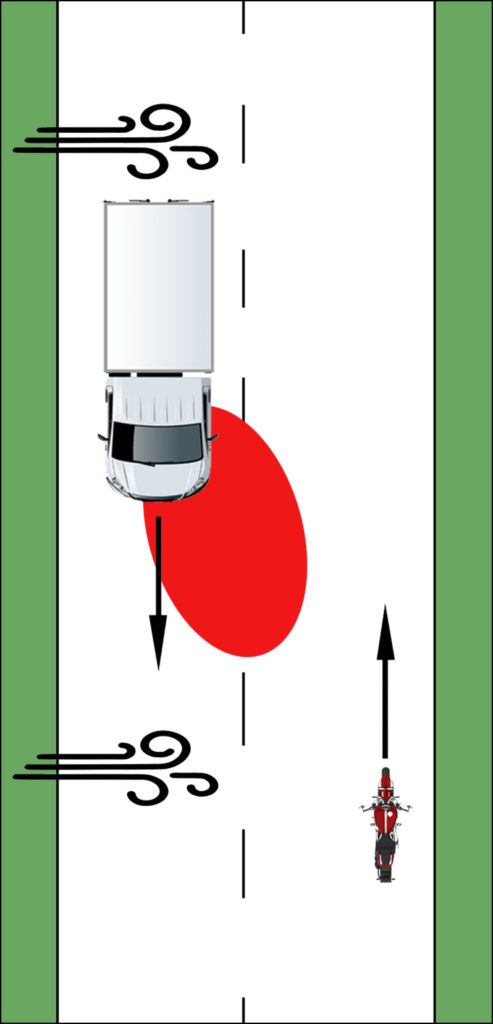
Know When To Say “No”
Those of you that have read my Amazon #1 best-selling travel book “Road Work: Images and Insights of a Modern Day Explorer” have already heard a story about when riding in high winds literally made me call it quits after 350+ miles of trying to reason with it. I tried everything. An interstate. Some secondary roads. Some “protected” back roads. I endured crosswinds for 300 miles before changing my route to put the wind at my back. On that particular day I was treated to a steady 35MPH wind with gusts up to 60MPH! All. Day. Long. At one point I nearly got knocked to the ground while simply waiting at a traffic light. Stopped. With both feet on the ground. Obviously I survived the ordeal but it was not pleasant. At all. It was no day for someone who doesn’t have extensive experience riding in challenging conditions. When in doubt; put it down for the night and carry on tomorrow. No ride is worth your life.
Riding In High Winds • Conclusion
That will wrap it up for today’s episode on riding in high winds. There’s more that could be said; particularly regarding the use of appropriate eye protection, etc. We’ll leave those subjects for another time. We hope this post enlightened some of you regarding the intricacies of this type of riding. Like Riding In The Rain, it’s not a preferred scenario, but it’s something that can be handled safely and with confidence. Feel free to leave a comment below. If you have specific questions you need addressed, please feel free to contact us directly via email. Be sure to subscribe to Roadcraft USA to receive alerts when new posts hit the blog.
Please help support the Roadcraft USA online resource by making product purchases through the links in this post. As Amazon Associates we earn commissions from qualifying purchases made through these links. There is no additional cost to you whatsoever. Thank you for your support!
Click Here to view an interactive visual index page where you can quickly browse through all of the great features that are published on the Roadcraft USA blog.

